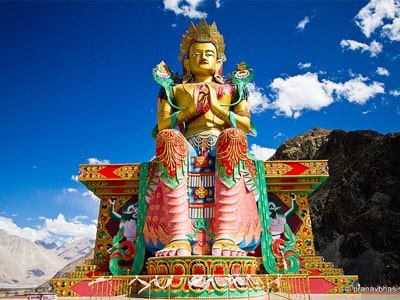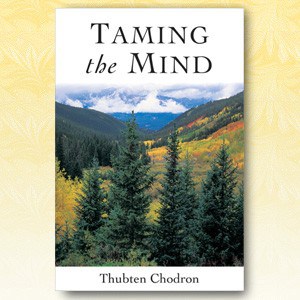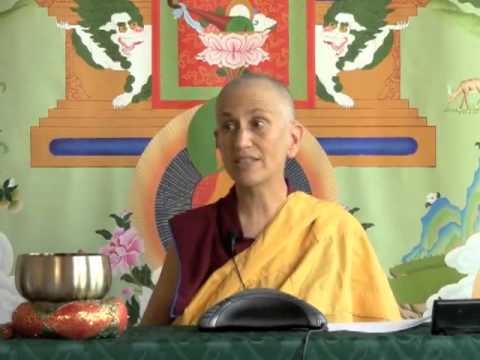A Presentation of the Establishment of Mindfulness

A Presentation of the Establishment of Mindfulness is from the fourth chapter of Gyaltsen's General Commentary to the Ornament of Clear Realization. The Ornament of Clear Realization is by Maitreya. Gyaltsen's root text was the basis of a series of teachings by Venerable Thubten Chodron on the establishment of mindfulness on the body, feelings, mind and phenomena.
There are eight parts to this decisive final analysis of the establishment of mindfulness:
- observed objects
- manners of meditation
- reasons for meditating
- nature
- divisions
- boundary
- etymology
- demonstrating the establishments of mindfulness in the Mahayana as superior
1. Observed objects
There are four observed objects for the establishment of mindfulness: the body, feelings, mind, and phenomena.
There are three types of body:
- external body of forms comprising the five: visual forms, sounds etc. that are not sense powers
- internal body comprising the five sense bases such as the eye sense power
- the body that is both external and internal, such as the visual forms etc. that make up the (gross) sense organs
There are three types of feeling:
- pleasure
- pain
- neutral
“Mind” refers to the primary consciousnesses (the visual consciousness and so forth).
“Phenomena” refers to all mental factors that are not feelings, as well as all abstract composites and unconditioned phenomena. This is so since in the Compendium of Abhidharma it states:
What are the observed objects for the establishment of mindfulness? The body, feelings, mind and phenomena.
The Compendium of Knowledge states:
What are the objects of observation of the establishments of mindfulness? The body, feelings, mind, and phenomena.
The reason these four objects are stated as the observed objects is to stop the childish from grasping:
- the body to be the basis of (their) identity (I or self)
- the feelings to be the source of enjoyment of that self
- the mind to be the actual self
- phenomena such as attachment as afflicting and phenomena such as confidence (faith) as purifying the self
The Compendium of Knowledge states:
Furthermore, they are the thing that is the dwelling place of the self, the bases for the enjoyment of the self, the actual self and the things that afflict and purify the self.
2. Manners of meditation
There are two manners of meditation:
- the common manner of meditation
- the uncommon manner of meditation
Common manner of meditation
The common manner of meditation is done by examining both the general and specific characteristics of the body, feelings, mind, and phenomena. The Treasury of Knowledge states:
We should meditate on establishment of mindfulness by thoroughly examining the two characteristics of body, feelings, mind, and phenomena.
Furthermore, the general characteristics are:
- impermanence
- unsatisfactoriness (dukkha)
- empty
- selfless
They are explained as general characteristics in relation to particular bases. That is to say:
- all conditioned phenomena are impermanent
- all polluted phenomena are unsatisfactory
- all phenomena are empty and selfless
The Commentary to the Treasury of Knowledge states:
Their specific characteristics are their individual natures. The general characteristics are that all conditioned phenomena are impermanent, all polluted phenomena are unsatisfactory and all phenomena are empty and selfless.
Hence, with respect to the specific characteristics:
- the body has the nature of the primary and secondary elements
- the feelings have the nature of experience
- the mind has the nature of the observer
- phenomena, i.e. the mental factors and so forth, have their own individual natures
The above (explanation) is merely an indication (of what should be practiced).
Uncommon manner of meditation
This has three parts:
- the observed objects
- the attention (mental engagement)
- the attainment
The observed object
Hearers and solitary realizers observe only their own bodies and so forth, while bodhisattvas observe the bodies of both themselves and others.
The attention
Hearers and solitary realizers are attentive to (body, feelings, mind and phenomena) as impermanent and so forth, while bodhisattvas meditate upon the characteristic (i.e. identity) of phenomena being non-observable.
The attainment
Hearers and solitary realizers meditate solely to be free from the polluted body and so forth, while bodhisattvas do not meditate for the sake of either freedom or non-freedom from these, but to attain non-abiding nirvana.
3. Reason for meditation
The reason for meditating in this way is to engage us in what to practice and what to abandon with respect to the Four Noble Truths.
- Through meditating on the establishment of mindfulness on the body, we will know the polluted body to have the nature of karmically-produced dukkha. (relates to truth of suffering)
- Through meditating on the establishment of mindfulness on the feelings, we will understand by their results that:
- the feeling of pleasure is the cause for the craving that desires not to be separated from (pleasure);
- the feeling of pain is the cause for the craving that desires to be separated from (pain).
- Also, since craving is the foremost among the impure minds, we will proceed to abandon it. (relates to truth of cause)
- In the establishment of mindfulness on the mind, through analyzing the mind—the basis for the grasping of an identity (self)—to be impermanent and so forth, we will cease to grasp it as such (an identity that is impermanent, and so forth). Then, since we will no longer fear the annihilation of our identity, we will (be able to) actualize a cessation. (relates to truth of cessation)
- Through meditating on the repulsive (aspects of the body) and on the establishment of mindfulness on phenomena, we will know that all thoroughly afflicted phenomena are incompatible (with liberation and enlightenment), and that all pure phenomena are the antidotes to them. (relates to truth of the path)
Therefore, when these points are known and we understand these practices to be methods for turning away from harm and understand how to cultivate them, we will be led to (engage in) the Four Noble Truths. The Differentiation of the Middle Way and the Extremes says:
Because (the body) is karmically-produced suffering, because (the feelings) are the cause of craving, because (the mind) is the basis (for an identity), and because (the path) is (the source of) non-ignorance, we are led to the Four Noble Truths. Therefore, meditate on establishment of mindfulness.
4. Nature
The definition of establishment of mindfulness is: an exalted knower of a person who has entered the path, which is associated with either mindfulness or wisdom and which meditates after examining the general and specific characteristics of the body, feelings, mind and phenomena. As it says in the Compendium of Knowledge:
What is the nature (of the establishment of mindfulness)? Wisdom and mindfulness.
Also, from the Treasury of Knowledge says:
The establishment of mindfulness is wisdom.
5. Divisions
There are four kinds of establishment of mindfulness, those on the body, feelings, mind, and phenomena.
6. Boundary
The establishments of mindfulness exist from the path of accumulation through the Buddha’s ground.
7. Etymology
By being mindful of an object observed by wisdom, it is said to be “establishment,” and since we do not forget it, it is said to be “establishment of mindfulness.”
8. Demonstrating the (practice of) establishment of mindfulness in the Mahayana as superior
The establishment of mindfulness in the Mahayana is superior to that of the Fundamental Vehicle because meditation on it is superior in 14 ways:
- Its aim is the Mahayana
- It relies on the wisdom (that comprehends the lack of self of phenomena)
- It acts as a remedy to the sixteen mistaken views
- It engages us in meditation on the Four Noble Truths
- It observes the body and so forth of all (beings), both ourselves and others
- It is attentive to the body and so forth being empty (of inherent existence)
- It helps us to attain an unpolluted body, after having been freed from a polluted body
- It accords with the six far-reaching practices
- It accords with caring for the hearers, solitary realizers, and so forth
- (Through it) we know the body to be like an illusion, the feelings to be like a dream, the mind to be like space, and phenomena to be like clouds
- In accord with our intention, we will be born in cyclic existence as a wheel-turning monarch and so forth
- We will have naturally sharp faculties
- Meditation on the establishment of mindfulness is not mixed with a Fundamental Vehicle aspiration
- We obtain nirvana without remainder
These qualities are further substantiated in the Ornament of the Mahayana Sutras:
Because the wise (bodhisattva) is incomparable in 14 ways in his/her meditation on the establishment of mindfulness, he/she is superior to others.
Furthermore,
He/she is superior to others because of the reliance and the remedial forces. Similarly because of what he/she engages in, the aim and the attention, the attainment and the superiority of the meditation, being in accord with what is accepted, the total knowledge and the birth, the greatness and the superiority, the meditation and the perfect accomplishment.
The above are mere indications (of the practice). A more extensive (explanation) can be found elsewhere.
Translated from Tibetan by Gelong Jampa Tupkay (1978), and revised by Dawa Dondup and Venerable Wendy Finster (1990) and edited by Venerable Thubten Chodron (2010).
Jetsun Chokyi Gyaltsen
Jetsun Chokyi Gyaltsen (1464 - 1544) is the author of the Sera Jey Monastery's principal scriptural studies. His Holiness is one of the most distinguished learned scholars in the history of Sera Jey Monastery. During his lifetime, he wrote many volumes on philosophical studies and authored several books on the works of Lama Tsongkhapa's two closest disciples. Later his publications were incorporated into the monastic course that formed the integral part of the study curriculum and that is followed to this present day. (Source SeraJeyMonastery.org)


